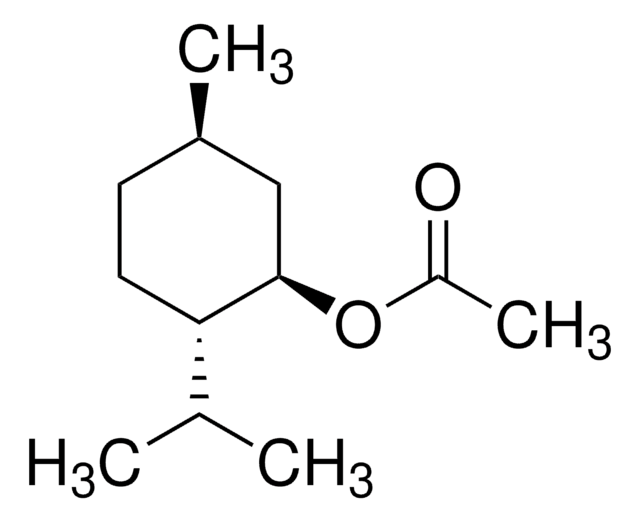16254
Thymol
meets analytical specification of Ph. Eur., BP, NF, 99-101%
Sinónimos:
2-Isopropyl-5-methylphenol, 5-Methyl-2-(1-methylethyl)phenol, 5-Methyl-2-isopropylphenol, IPMP
About This Item
meets analytical specifications of NF
meets analytical specifications of Ph. Eur.
Productos recomendados
agency
meets analytical specifications of BP
meets analytical specifications of NF
meets analytical specifications of Ph. Eur.
Quality Level
vapor pressure
1 mmHg ( 64 °C)
assay
99-101%
form
solid
quality
meets analytical specification of Ph. Eur., BP, NF
impurities
acidic reac. impurities, complies
organic volatile impurities, complies (GC)
related subst., complies (GC)
residual solvents, complies
≤0.05% non-volatile matter
bp
232 °C (lit.)
mp
48-51 °C (lit.)
48-51 °C
density
0.965 g/mL at 25 °C (lit.)
suitability
complies for appearance of solution
SMILES string
CC(C)c1ccc(C)cc1O
InChI
1S/C10H14O/c1-7(2)9-5-4-8(3)6-10(9)11/h4-7,11H,1-3H3
InChI key
MGSRCZKZVOBKFT-UHFFFAOYSA-N
¿Está buscando productos similares? Visita Guía de comparación de productos
Application
- the effect of thymol on the viability of Bacillus cereus.
- its effect on growth and production of citrinin from Penicillium citrinum.
- the effect of thymol on insect and human γ-aminobutyric acid (GABA) receptors.
Biochem/physiol Actions
Disclaimer
signalword
Danger
hcodes
Hazard Classifications
Acute Tox. 4 Oral - Aquatic Chronic 2 - Eye Dam. 1 - Skin Corr. 1B
Storage Class
8A - Combustible corrosive hazardous materials
wgk_germany
WGK 2
flash_point_f
240.8 °F - closed cup
flash_point_c
116 °C - closed cup
ppe
dust mask type N95 (US), Eyeshields, Faceshields, Gloves, type P3 (EN 143) respirator cartridges
Elija entre una de las versiones más recientes:
¿Ya tiene este producto?
Encuentre la documentación para los productos que ha comprado recientemente en la Biblioteca de documentos.
Los clientes también vieron
Bacillus cereus Heat-Treated Vegetative Cells
Nuestro equipo de científicos tiene experiencia en todas las áreas de investigación: Ciencias de la vida, Ciencia de los materiales, Síntesis química, Cromatografía, Analítica y muchas otras.
Póngase en contacto con el Servicio técnico









